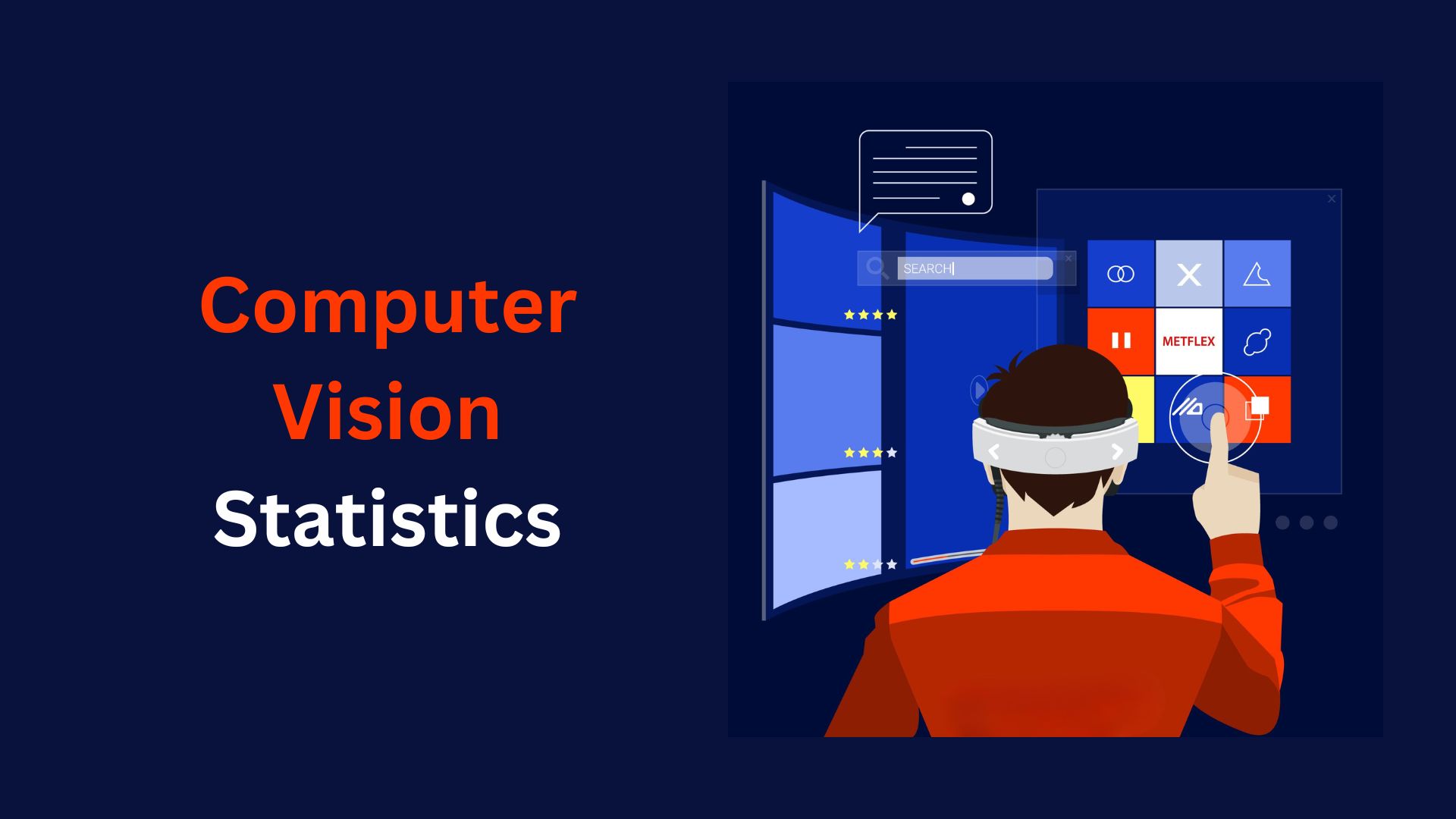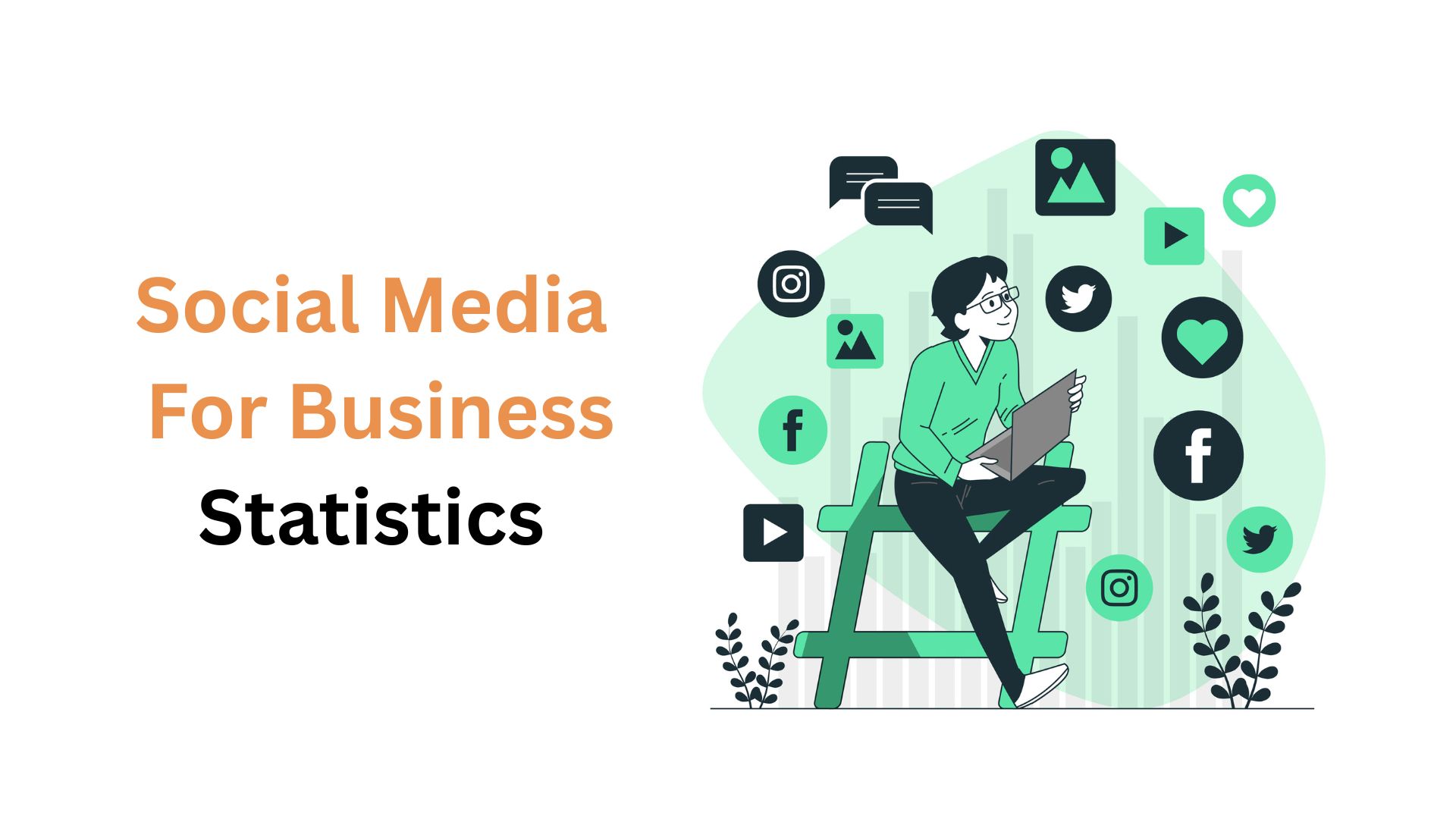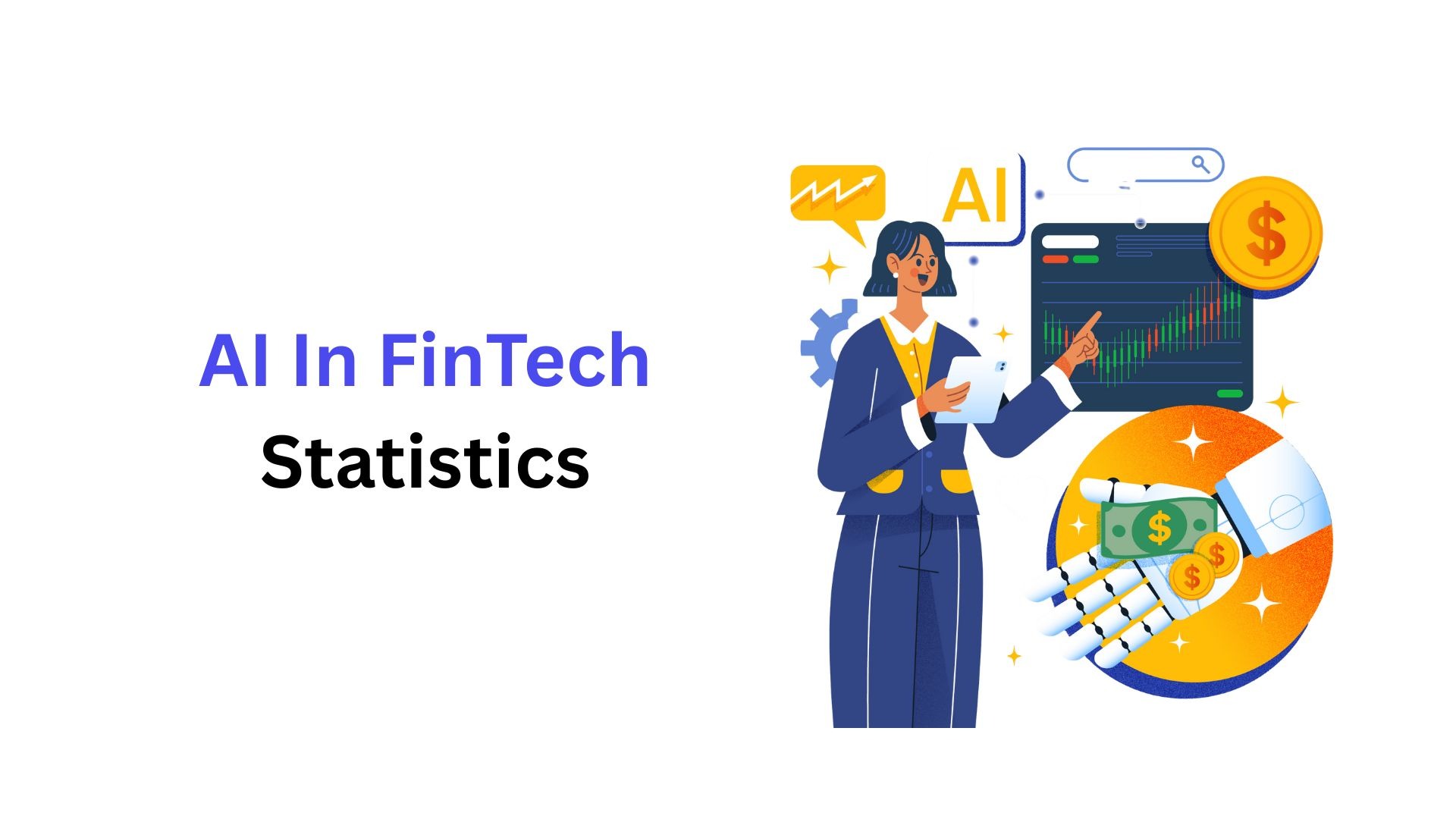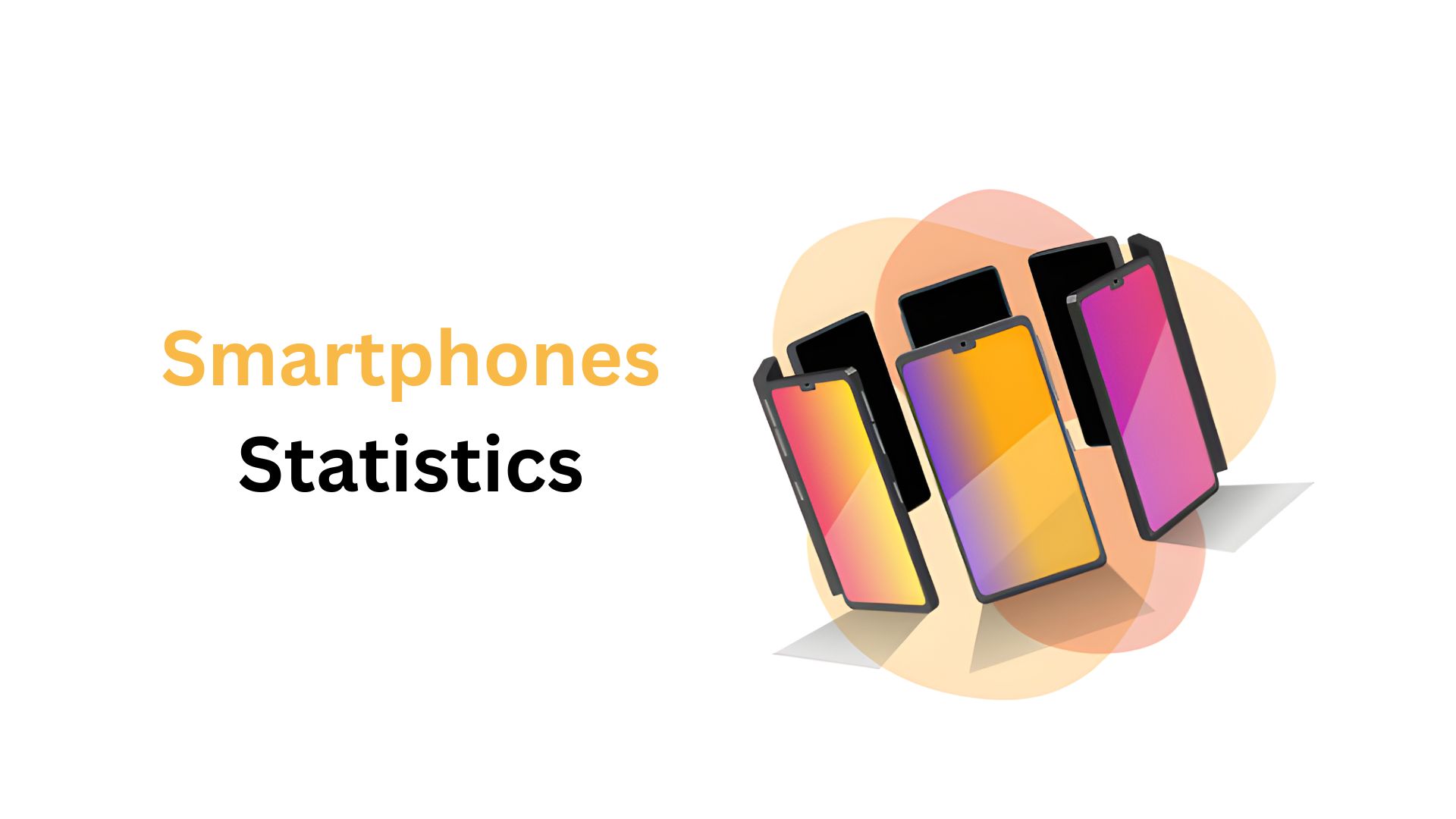AI In Business Statistics By Industry, Region And Facts (2025)
Updated · Jun 27, 2025
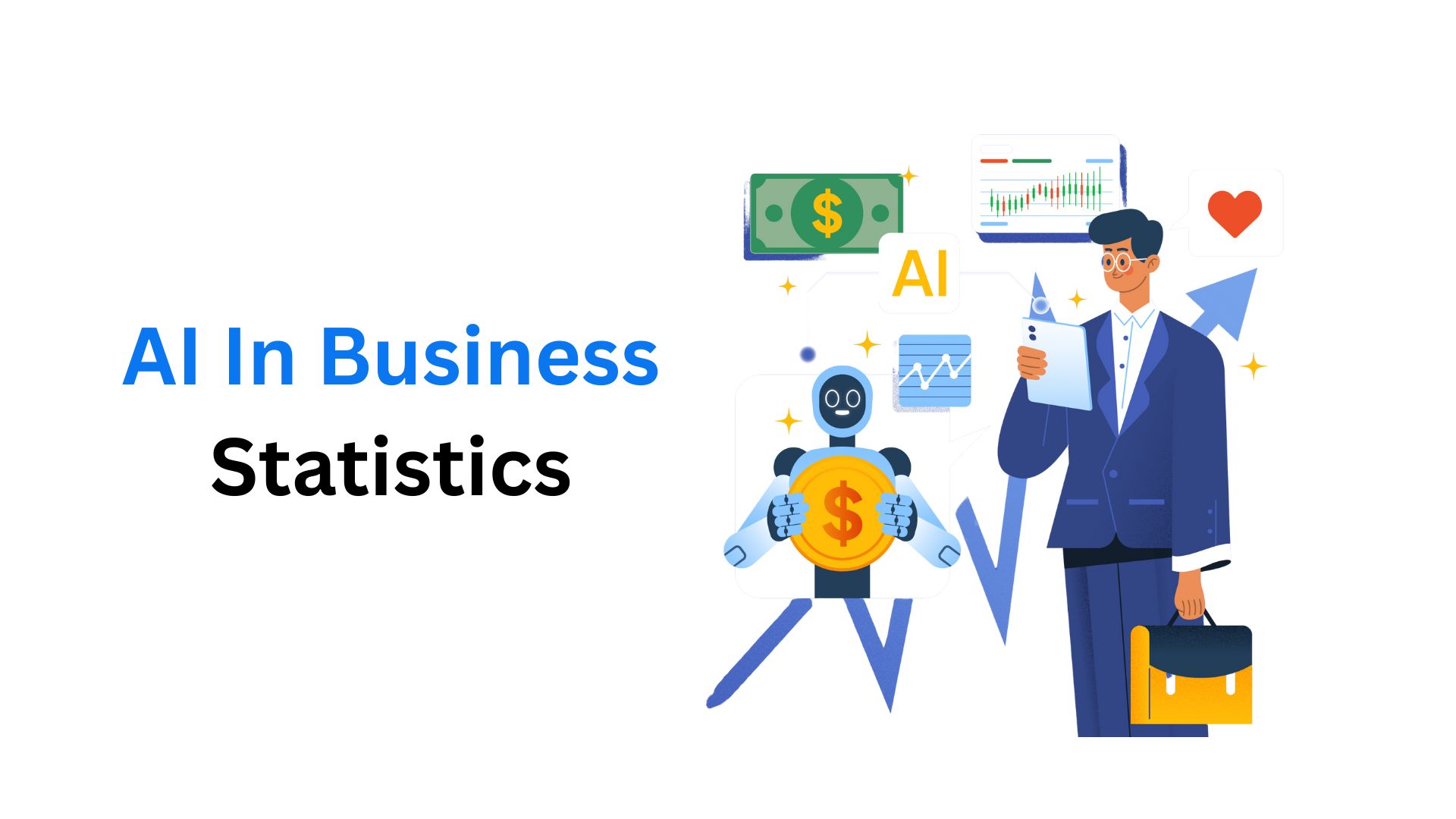
Table of Contents
- Introduction
- Editor’s Choice
- AI Usage Statistics In Businesses
- Use Cases of AI In The Workplace Statistics
- AI In The Healthcare Industry Statistics
- AI In The Edtech Industry Statistics
- AI In The Banking Industry Statistics
- AI In Consumer Retail Industry Statistics
- AI In The Manufacturing Sector Statistics
- Market Share On AI Voice Assistants Statistics
- Smart Speaker AI Company Statistics
- Global AI Adoption In Business Statistics By Region
- Benefits of ChatGPT For Businesses
- Potential AI Benefits Statistics In U.S. Businesses
- Disadvantages of AI In Business Statistics
- Conclusion
Introduction
AI In Business Statistics: In today’s world, global businesses are rapidly transforming with Artificial Intelligence (AI), and as a result, overall operations are becoming easier in almost every industry. From automating regular tasks to enabling smarter decision-making, AI is also helping companies boost efficiency, increase productivity, reduce costs, enhance software development, improve customer experiences, and increase overall output.
This article includes several statistical analyses from different sources that elaborate on the overall AI-enhancing business sectors, along with their advantages and disadvantages.
Editor’s Choice

(Source: buttercms.com)
- The above image indicates that, as of 2025, 78% of global companies have implemented AI.
- Interestingly, 71% of businesses claimed that they now use generative AI in at least one part of their work.
- According to the reports of Vena Report analysis, by the end of 2030, AI is projected to generate 170 million new jobs.
- During the same period, the global AI market is expected to exceed USD 1.8 trillion.
- AI is expected to contribute to a 26% increase in the GDP of local economies by 2030.
- Generative AI could help the banking industry grow by USD 340 billion.
- About 73% of employers say hiring people with AI skills is a top priority.
- Around 60% of business owners believe using AI will help increase their sales.
- A company saw a 30% rise in customer satisfaction after starting to use AI tools.
- More than 50% of senior leaders admit they don’t feel ready to handle how fast AI is growing.
- Employees who use AI say it helps them get 80% more work done and boosts their productivity.
AI Usage Statistics In Businesses
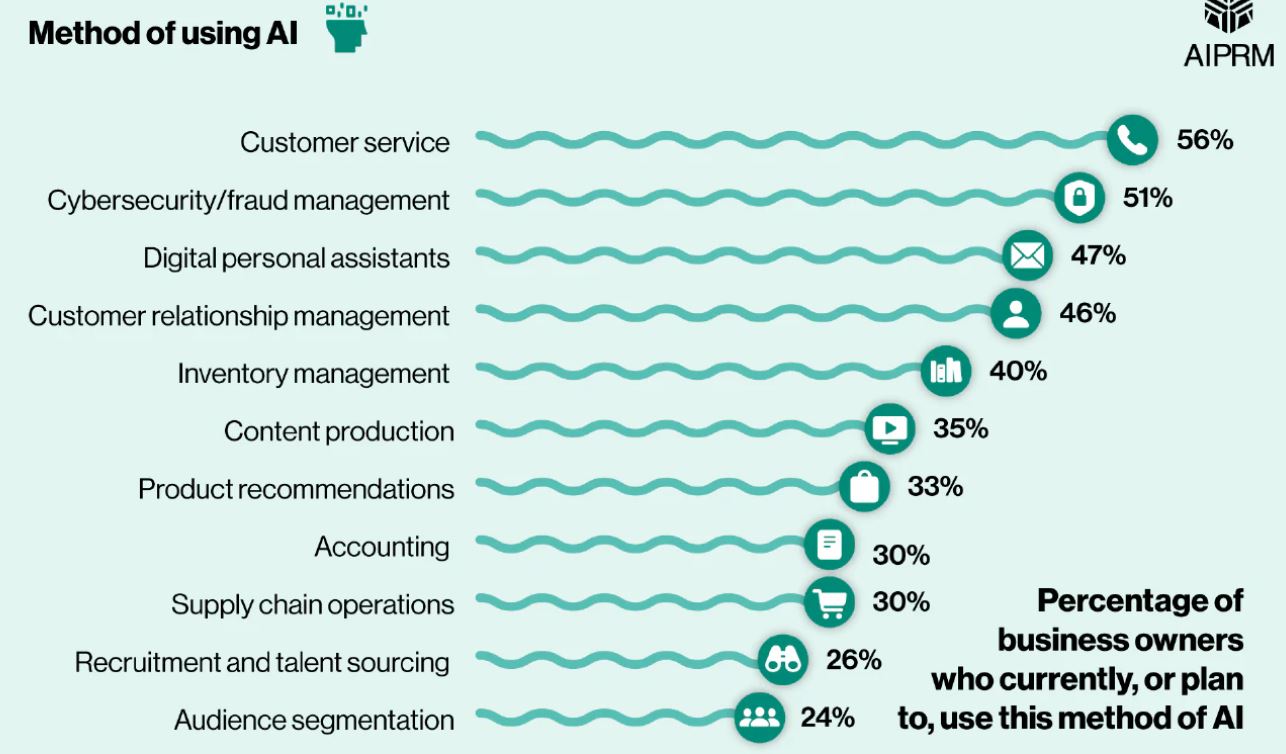
(Source: aiprm.com)
- The above graph indicates that the most common applications of AI in business are customer service (56%), cybersecurity and fraud management (51%), and digital personal assistants (47%).
- Other usage shares are followed by customer relationship management (46%), inventory management (40%), content production (35%), product recommendations (33%), accounting (30%), supply chain operations (30%), recruitment and talent sourcing (26%), and audience segmentation (24%).
Use Cases of AI In The Workplace Statistics
- According to the AIPRM report analysis, 78.5% of people use AI through email spam filters at workplaces.
- Meanwhile, 62.2% said they use chatbots to handle customer service questions.
Furthermore, other types of shares are stated in the table below:
| Types | Approx. AI Share |
| Algorithmic recommendations through playlists | 39% |
| Wearable fitness devices and trackers | 36% |
| Voice recognition software | 30% |
| Algorithmic recommendations for purchasing | 30% |
| Virtual assistants | 29% |
| Face recognition software | 26% |
| Smart thermostats and energy meters | 22% |
| Other language models | 21% |
| Smart kitchen devices | 15% |
| Virtual reality headset for online gaming | 15% |
| Driving an autonomous vehicle | 10% |
AI In The Healthcare Industry Statistics
- According to Gitnux reports, approximately 80% of the global healthcare industry is currently adopting AI technologies to enhance patient care.
- The market size of AI in the healthcare industry is expected to reach around USD 45.2 billion by the end of 2026, with a CAGR of 33.4%.
- In this sector, AI is expected to reduce diagnostic errors by up to 50% by 2025.
- AI symptom checkers can correctly identify common health problems about 80% of the time.
- To improve efficiency and patient outcomes, 60% of hospitals use AI reports, while over 40% of healthcare data use AI algorithms.
- In the last two years, the use of AI chatbots has increased by 75% for initial patient consultation.
- In the North American healthcare sector, the adoption rate of AI in radiology exceeds 70%.
- To analyse medical images, AI algorithms helped the process 60 times faster.
- To accelerate the development process, AI in drug discovery allows for cost savings of 50%.
AI In The Edtech Industry Statistics
- Similarly, the Gitniux report further states that globally, around 67% of educational institutions have already adopted AI tools in their teaching processes.
- By the end of 2027, the market size of AI in education is projected to reach USD 20 billion.
- Over the next five years, more than 80% of educational institutions plan to expand their use of AI-powered analytics.
- In AI research and development, almost 74% of educational technology companies are currently investing.
- As of 2025, AI tutors are now preferred by 65% of students.
- For personalised instruction, AI-based platforms are used by 58% of teachers in the U.S.
- AI also helped reduce the administrative workload by 52% among higher education institutions.
- 42% of students say that using AI tools helps them learn better and more efficiently.
- AI tools that check for plagiarism have helped cut down cheating in schools by 25%.
- About 70% of education technology startups now use AI as a key part of their products.
AI In The Banking Industry Statistics
- As of 2025, to enhance customer experiences, nearly 61% of banking institutions are currently using AI, according to reports from Gitnux.
- According to Gitnux, the size of AI in banking is expected to reach approximately USD 26 billion by 2026.
- In the next 5 years, AI will significantly transform the banking industry, as claimed by 85% of banking executives.
- The costings of the banking sector have reduced by 22% after implementing AI.
- By 2025, AI-based risk management tools had been adopted by 78% of banks.
- AI-driven chatbots handle 70% of customer queries in banking, while 60% of banks use AI to detect and prevent fraud cases.
- Approximately 50% of workers utilise AI tools to manage their everyday tasks.
- In contrast,68% of customers report feeling happier with banks that offer them AI-based personal services.
- AI fraud detection systems help cut false alarms by 25%.
- After implementing AI in financial institutions, revenue has increased by 9%.
AI In Consumer Retail Industry Statistics
- By the end of 2027, the global market size of AI in retail is projected to reach USD 24.87 billion.
- After implementing AI, shoppers with bra implement these solutions, which offer consumers.
- AI is helping them better understand customer preferences, as stated by 65% of retail decision-makers.
- According to 62% of retail executives, AI is crucial for gaining a competitive advantage. In this sector, AI-driven chatbots handle 80% of customer queries.
- To enhance supply chain resilience, 58% of retail brands utilise AI. AI improves productivity, as believed by 59% of retail employees. 54% of retailers are now investing in AI tools to manage their inventory better, and 58% are using AI to strengthen their supply chains.
- Around 45% of shoppers prefer product suggestions generated by AI.
- Using AI for demand forecasting is 30% more accurate than older methods.
- It also helps reduce out-of-stock issues by 25%.
- On top of that, AI-powered pricing strategies have helped stores boost profits by about 15% on average.
AI In The Manufacturing Sector Statistics
- A report published by Averroes estimates that the global market size of AI in the manufacturing industry will reach USD 20.8 billion by the end of 2028, with a 45.4% CAGR growth rate.
- AI transformation in the manufacturing industry has helped optimise delivery costs by 15% and reduce design time by 50%. The automotive sector leads with a 25% adoption rate, followed by electronics at 20%.
- AI visual inspection detects 97% of defects, compared to 70% when performed by people.
- Within the next 5 years, AI solutions are expected to be implemented by 70% of manufacturers in the industry. Using AI for predictive maintenance can reduce machine downtime by up to 30%.
- Moreover, AI in quality control also helps spot defects more accurately, improving detection rates by over 90%.
- As of 2024, over 8.4 billion devices now use AI assistants, double the earlier figure, says Search Logistics.
- Apple and Google together hold 72% of the total AI market share.
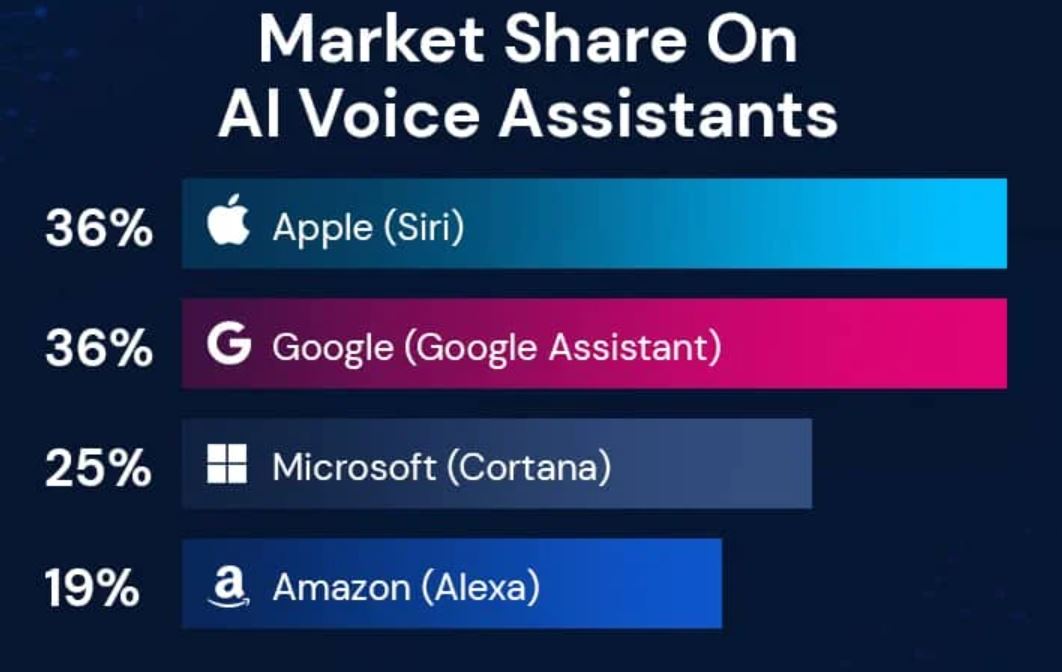
(Source: searchlogistics.com)
- In the market of AI Voice Assistants, Apple (Siri) and Google (Google Assistant) captured a market share of 36%, respectively.
- Microsoft (Cortana) controls 25% of the voice assistant market, and Amazon (Alexa) holds about 19% of the total market.
Smart Speaker AI Company Statistics
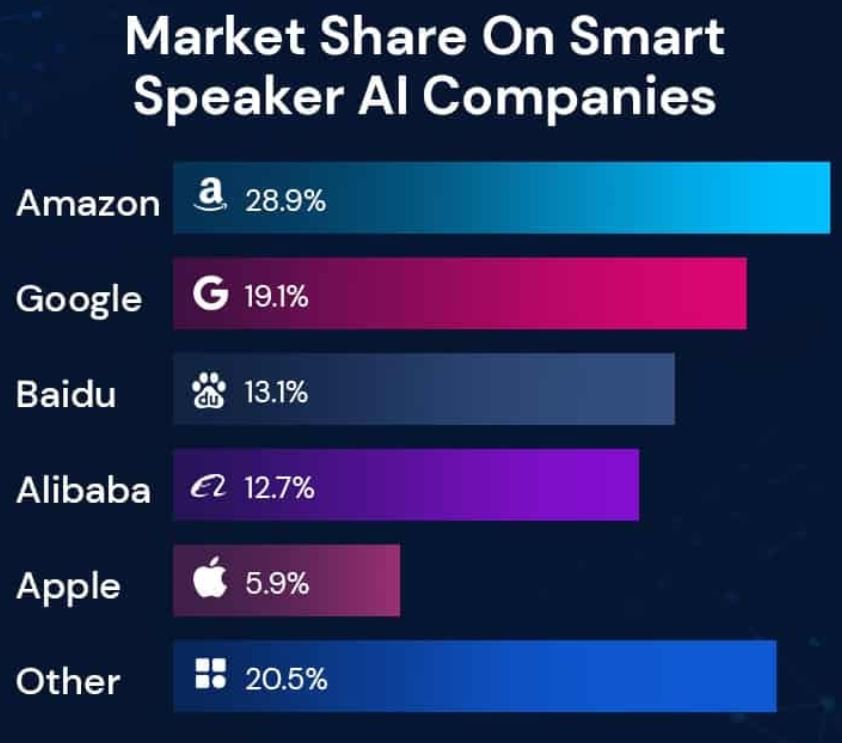
(Source: searchlogistics.com)
- The above image indicates that Amazon and Google are the top two leaders in the smart speaker market, holding shares of 28.9% and 19.1%, respectively.
- Furthermore, other smart speaker company shares are followed by Baidu (13.1%), Alibaba (12.7%), Apple (5.9%), and others (20.5%).
Global AI Adoption In Business Statistics By Region
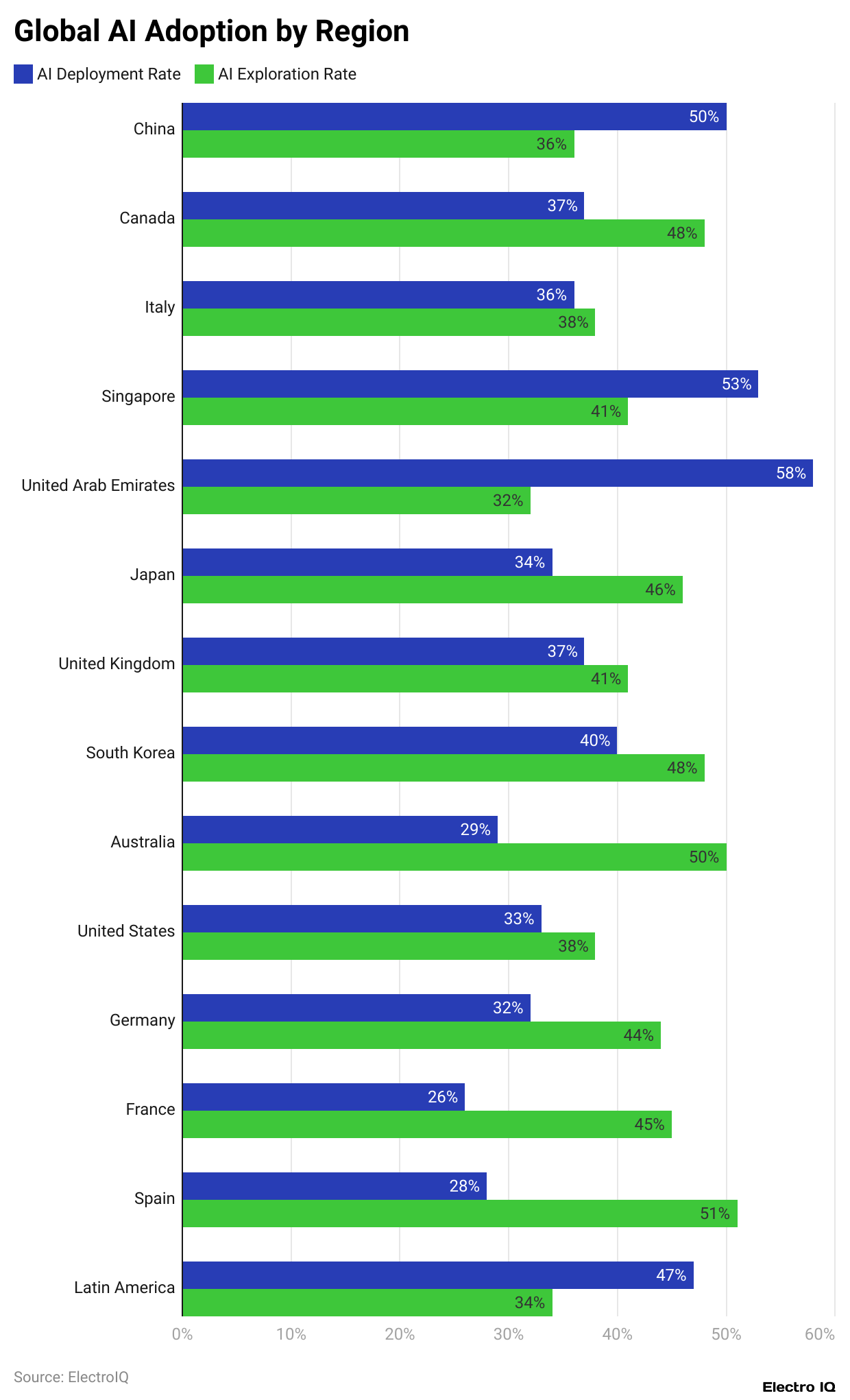
(Reference: buttercms.com)
- In 2025, the AI development rate of global businesses is expected to account for 42%, followed by the AI exploration rate at 40%.
- In the same period, India has become the top country for using AI in business, with 59% of companies adopting it and 27% of companies exploring it.
The rest of the countries’ analyses of 2025 are stated below:
| Country | AI Deployment Rate | AI Exploration Rate |
| China | 50% | 36% |
| Canada | 37% | 48% |
| Italy | 36% | 38% |
| Singapore | 53% | 41% |
| United Arab Emirates | 58% | 32% |
| Japan | 34% | 46% |
| United Kingdom | 37% | 41% |
| South Korea | 40% | 48% |
| Australia | 29% | 50% |
| United States | 33% | 38% |
| Germany | 32% | 44% |
| France | 26% | 45% |
| Spain | 28% | 51% |
| Latin America | 47% | 34% |
Benefits of ChatGPT For Businesses
- According to business owners, 74% of them respond to customers.
- In contrast, 70% think it will speed up content creation, while 58% expect more personalised customer experiences.
| AI Benefit | Business Share |
| Increase web traffic | 57% |
| Streamline job processes | 53% |
| Summarize information | 53% |
| Improve decision-prefer | |
| Improve business regenerality | 47% |
| Translate information | 47% |
| Generate responses to colleagues | 46% |
| Create content in different languages | 44% |
| Fix coding errors | 41% |
| Generate website copy | 30% |
Potential AI Benefits Statistics In U.S. Businesses

(Source: aiprm.com)
- The above pie chart indicates that43.1 43.1% growth rate in transformation productivity. In comparison, 39.4% think it woptimiseove decisicostsaking at worreduceermore, others are followed by reducing the risk of era rors (35.3%) rate, reducing response time (34%), streamlining job processes (30.9%), improve customer relationships (30.8%), save costs (25.3%), increase sales (19.6%), and non of the above (4.1%).
Disadvantages of AI In Business Statistics
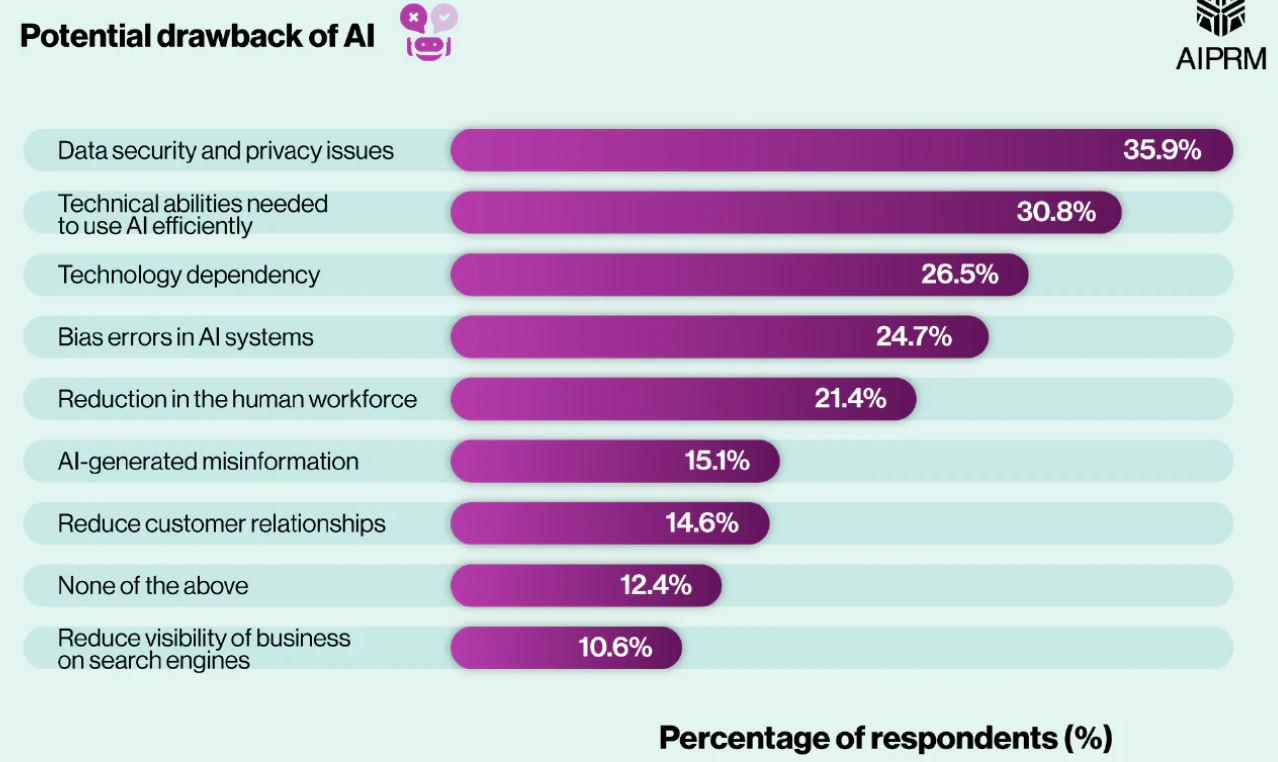
(Source: aiprm.com)
- Around 35.9% of AI-linked businesses stated that the potential drawback of Artificial Intelligence is data security and privacy issues.
- The next two issues are technical abilities needed to use AI efficiently, stated by 30.8% of businesses, and technological dependency, by 26.5%.
- Furthermore, others are followed by bias errors in AI systems (24.7%), reduction in the human workforce (21.4%), AI-generated misinformation (15.1%), reduce customer relationships (14.6%), reduced visibility of business on search engines (10.6%), and none of the above (12.4%).
Conclusion
After completing the article on AI in Business Statistics, it can be concluded that Artificial Intelligence is already known as a powerful business tool that helps today’s businesses to grow faster, along with smarter work performance, and provides better customer service.
From improving efficiency to making smarter decisions, AI is helping global companies across all industries stay competitive. As adoption continues to rise, businesses that embrace AI now are more likely to lead in the years ahead.
Sources
FAQ.
There are ten key steps to using AI safely in businesses, which include setting clear goals, utilising trusted AI tools, protecting data privacy, mitigating bias in AI, training employees, maintaining transparency, monitoring performance, having a contingency plan, adhering to ethical guidelines, and keeping software up to date.
AI supports business strategy by enhancing decision-making, predicting trends, automating tasks, improving customer experience, and increasing overall efficiency.
AI in everyday businesses allows for saving time, better customer support, smarter decisions, cost efficiency, personalised marketing, improved security, and inventory & supply management.

Tajammul Pangarkar is the co-founder of a PR firm and the Chief Technology Officer at Prudour Research Firm. With a Bachelor of Engineering in Information Technology from Shivaji University, Tajammul brings over ten years of expertise in digital marketing to his roles. He excels at gathering and analyzing data, producing detailed statistics on various trending topics that help shape industry perspectives. Tajammul's deep-seated experience in mobile technology and industry research often shines through in his insightful analyses. He is keen on decoding tech trends, examining mobile applications, and enhancing general tech awareness. His writings frequently appear in numerous industry-specific magazines and forums, where he shares his knowledge and insights. When he's not immersed in technology, Tajammul enjoys playing table tennis. This hobby provides him with a refreshing break and allows him to engage in something he loves outside of his professional life. Whether he's analyzing data or serving a fast ball, Tajammul demonstrates dedication and passion in every endeavor.

